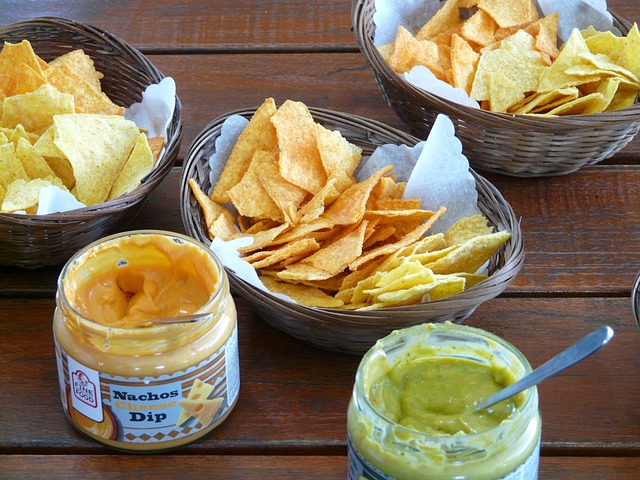The Basic Tortilla Chips Mission focuses on creating a crispy, flavorful snack with improved nutrition. Traditionally made from corn tortillas fried in vegetable oils, these chips offer a balance of calories but lack essential nutrients like protein and fiber. Health-conscious consumers seek lower-fat, reduced-sodium alternatives to commercial varieties. The mission aims for a 30g serving containing around 150 calories, 10-15g fat (including unsaturated fats), and 20-25g carbs, emphasizing portion control and high-quality ingredients for pairing with lighter dips, despite their higher calorie density compared to some alternatives.
Looking for a healthier alternative to traditional tortilla chips? In this comprehensive guide, we explore the mission to replace basic tortilla chips with delicious and nutritious options. We start by understanding the components and nutritional value of conventional chips, highlighting potential health concerns tied to their regular consumption. Next, we delve into innovative plant-based and low-carb alternatives, analyzing key ingredients like cauliflower and sweet potatoes, and how they stack up nutritionally. Finally, we provide tips for incorporating these healthier swaps into your diet, along with ideas for scrumptious dips and guacamoles that pair perfectly.
- Understanding Traditional Tortilla Chips: Ingredients and Nutritional Value
- – A breakdown of the components that make up traditional tortilla chips
- – Analysis of their nutritional profile: calories, fat content, carbohydrates, etc.
Understanding Traditional Tortilla Chips: Ingredients and Nutritional Value

Traditional tortilla chips, a staple in many households and restaurants, are typically made from corn tortillas that are cut into triangles and fried at high temperatures. The basic ingredients include corn flour, vegetable oil, salt, and sometimes other flavorings like paprika or garlic powder. While they’re often enjoyed as a snack on their own or with dips, their nutritional profile is worth examining.
A typical serving of Basic Tortilla Chips (around 30g) contains around 150 calories, primarily from fat and carbohydrates. They offer minimal protein and fiber, and the high-temperature frying process can lead to increased levels of unhealthy trans fats and acrylamide, a potential carcinogen formed when starchy foods are cooked at very high temperatures. Understanding these aspects highlights the need for healthier alternatives that retain the taste and texture of traditional tortilla chips without compromising nutritional value.
– A breakdown of the components that make up traditional tortilla chips

Traditional tortilla chips, a popular snack worldwide, are typically made from a simple combination of ingredients. The basic tortilla chips mission is to deliver a crispy texture and a subtle corn flavor. The primary component is wheat or corn flour, which forms the base of the chip. This flour is mixed with water, salt, and sometimes a leavening agent like baking soda, creating a dough. The dough is then rolled into thin sheets, cooked until lightly browned, and cut into triangular shapes to form the chips.
An essential aspect of traditional tortilla chips is their high fat content, often derived from vegetable oils, which contributes to their crispy texture and extended shelf life. Additionally, many commercial varieties are seasoned with salt or other flavorings during or after cooking to enhance their taste. This simple yet delicious snack has become a staple in many households, but health-conscious consumers often seek alternatives to reduce their intake of fat, sodium, and processed ingredients.
– Analysis of their nutritional profile: calories, fat content, carbohydrates, etc.

The nutritional profile of traditional tortilla chips is a key consideration when evaluating their healthiness. A typical serving (around 30 grams) of Basic Tortilla Chips Mission contains approximately 150 calories, with around 10-15 grams of fat and 20-25 grams of carbohydrates. While the fat content can be concerning for those watching their saturated fat intake, it’s important to note that many of these fats are unsaturated, which is generally considered beneficial for heart health. Carbohydrates in tortilla chips mostly come from corn or wheat, offering a source of energy but also impacting blood sugar levels.
Comparing these figures to other snack options reveals the potential advantages and drawbacks. While they might be more calorie-dense than some alternatives, their nutritional composition offers a balance that can fit into a balanced diet, especially when paired with lighter dips or sauces. The key lies in portion control and choosing high-quality ingredients, ensuring that even traditional tortilla chips can contribute to a healthy lifestyle.
In light of the above discussions, it’s clear that while basic tortilla chips serve a purpose in our diets, their traditional form can be less-than-ideal due to high fat and calorie content. Fortunately, many healthy alternatives now exist, offering better nutritional profiles without compromising taste or texture. By opting for these smarter snack choices, you can enjoy a satisfying crunch while supporting overall well-being. Remember, making small changes in your snacking habits can contribute significantly to a healthier lifestyle.
